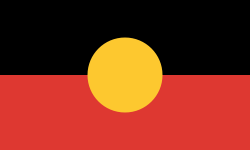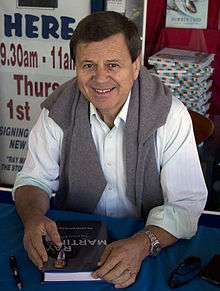Gamilaraay
 | |||||||||
| |||||||||
| Total population | |||||||||
|---|---|---|---|---|---|---|---|---|---|
| approx. 13,000 | |||||||||
| Regions with significant populations | |||||||||
| Languages | |||||||||
| Gamilaraay language, English and Aboriginal English | |||||||||
| Religion | |||||||||
| Christianity, Traditional | |||||||||
| Related ethnic groups | |||||||||
| Indigenous Australians | |||||||||
The Kamilaroi or Gamilaroi are an Indigenous Australian Murri people who are from the area which extended from around Singleton in the Hunter Valley through to the Warrumbungle Mountains in the west and up through the present-day centres of Quirindi, Gunnedah, Tamworth, Narrabri, Walgett, Moree, Lightning Ridge and Mungindi in New South Wales, to Nindigully in south west Queensland. The Kamilaroi is one of the four largest indigenous nations in Australia. The Kamilaroi language is classified in the Pama–Nyungan family of Australian languages. The Kamilaroi Highway, Sydney Ferries Limited's vehicular ferry "Kamilaroi" (1901–1933), and a cultivar of Durum wheat have all been named after the Kamilaroi people.[1]
History
The Gamilaroi were hunters and gatherers with a band-level social organization. Important vegetable foods were yams and other roots, as well as a sterculia grain, which was made into a bread. Insect larvae, frogs, and eggs of several different animals were also gathered. Various birds, kangaroos, emus, iguanas, possums, echidnas, and bandicoots were among the important animals hunted. Dingo pups were regarded as a delicacy. Fish were also consumed, as were crayfish, mussels, and shrimp. Men typically hunted, cleaned, and prepared the game for cooking. Women did the actual cooking, in addition to fishing and gathering. Individual Kamilaroi did not eat animals that were their totems.
The Gamilaroi or Gomilaroi from the word Kamil or Gamil meaning "no", are a large nation of Aborigines consisting of many tribes. The Gamilaroi are the second largest Aboriginal nation on the eastern side of Australia, and their language is known as Gamilaraay. The nation was made up of many smaller family groups who had their own parcels of land to sustain them. One of the great Kings of this tribe was ‘Red Chief’, who is buried near Gunnedah. The last link with tribal law and custom in Mungindi would be the forebear of the present Cubby family, who was the last known Respected Elder in the tribe. The Kamilaroi were regarded as fierce warriors and there is ample evidence of intertribal warfare. The Northern Gamilaroi people have a strong cultural connection with the Bigambul people, and the tribes met regularly for joint ceremonies at Boobera Lagoon near the present-day town of Goondiwindi.
Dreaming
Kamilaroi tradition includes Baiame, the ancestor or patron god. The Baiame story tells how Baiame came down from the sky to the land, and created rivers, mountains, and forests. He then gave the people their laws of life, traditions, songs, and culture. He also created the first initiation site. This is known as a bora; a place where boys were initiated into manhood. When he had finished, he returned to the sky, and people called him the Sky Hero or All Father or Sky Father. He is said to be married to Birrahgnooloo (Birran-gnulu), who is often identified as an emu, and with whom he has a son Daramulum (Dharramalan). In other stories Daramulum is said to be brother to Baiame. It was forbidden to mention or talk about the name of Baiame publicly. Women were not allowed to see drawings of Baiame nor approach Baiame sites, which are often male initiation sites (boras). In rock paintings Baiame is often depicted as a human figure with a large head-dress or hairstyle, with lines of footsteps nearby. He is always painted in front view; Daramulum is drawn in profile. Baiame is often shown with internal decorations such as waistbands, vertical lines running down the body, bands and dots.
Notable Gamilaroi people
- George Rose - NRL player for Manly Sea Eagles
- Jonathan Wright - NRL player for Cronulla Sutherland Sharks
- Greg Bird - NRL player for Gold Coast Titans
- Ben Jones - NRL player for Sydney Roosters in 2013 via their reserve grade team Newtown Jets.
- Michael Lett - Currently plays for the Illawarra Cutters in the NSW Cup
- Dale Shearer - Former Queensland and Australian Rugby League player
- Brad Tighe - NRL PLayer for Penrith Panthers
- Luke Walsh - NRL PLayer for Penrith Panthers
- Damien Hooper - Professional Boxer
- Cameron Hammond - Professional Boxer
- Adam Giles, Chief Minister of the Northern Territory
- Jason Gillespie - Australian Test cricketer
- Roger Knox - Country music singer known as "The Koori King of Country"
- Mundara Koorang - Artist, designer, teacher, elder, actor, and author
- Con Colleano - tightrope walker
- Ray Martin - TV Presenter
Alternative spellings
Various alternative spellings exist for Kamilaroi, such as Gomeroi, Gamilaroi, Gumillaroy, and Comelroy, all of which are attempts at transliteration to the Latin alphabet. Gamilaraay consists of "gamil" meaning "no" and the suffix "-(b)araay" meaning "having". Naming languages by their words for "no" ("no-having" languages) is a common practice in Australia.[2]
See also
References
- ↑ "Bellata Gold". Archived from the original on 2006-03-22. Retrieved 2006-04-21.
- ↑ Dixon, Robert M. W. The Languages Of Australia. Cambridge, Eng.: Cambridge University Press, 1980. Print.
External links
- Bibliographies of published, rare or special materials on Gamilaraay language and people, at the Australian Institute of Aboriginal and Torres Strait Islander Studies
.jpg)


